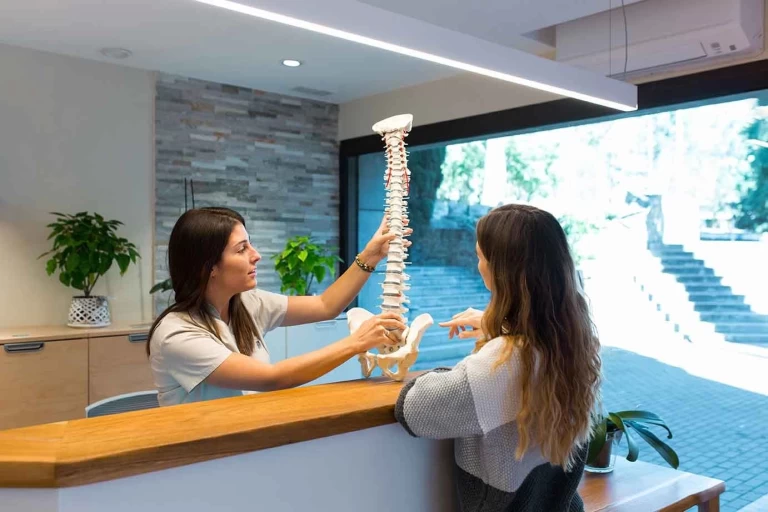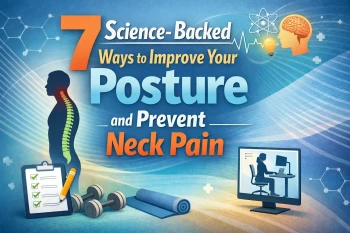
Your cervical spine is a vital part of your overall health and well-being. It allows you to move your head and neck and provides support for your brain and spinal cord. problems in your cervical spine can cause pain and other issues throughout your body. There are many different diseases and disorders that can affect your cervical spine. Some of the more common ones include:
- degenerative disc disease
- spondylosis
- whiplash
- herniated discs
- pinched nerves
Each of these conditions can cause symptoms like neck pain, stiffness, headaches, arm pain, and numbness or tingling in the hands or fingers. If you are experiencing any of these symptoms, it's important to see a chiropractor or other healthcare professional to get an accurate diagnosis and treatment plan.
Cervical spondylosis is the most common neck disorder, caused by wear and tear on the spine
Cervical spondylosis is the medical term for neck pain caused by wear and tear in the upper cervical spine. It typically affects middle-aged to older adults. Some common symptoms include headache, stiffness, and restricted range of motion in the neck. The condition is usually seen in people who have been exposed to long-term physical activities that cause added strain to the neck area such as prolonged sitting or typing. Treatment options can include physical therapy, medications, lifestyle changes, injections, or surgery depending on the severity of the condition. Although this disorder may be difficult to manage at times, care should be taken in order to alleviate chronic pain and discomfort associated with cervical spondylosis.
Degenerative disc disease can cause pain and stiffness in the neck
Degenerative disc disease, commonly referred to as arthritis of the spine, is a painful and damaging condition that can cause discomfort in the neck. It happens when the discs in between vertebrae start to break down, resulting in stiffness and pain when attempting even simple movements. The damaged discs can also put extra pressure on nerves, leading to additional pain elsewhere in the body such as radiating sensations down arms or legs. While degenerative disc disease does not have a cure, medical interventions and lifestyle changes such as exercise or posture improvements can be done to help bring relief from the symptoms. Unfortunately, it is a progressive condition, so patients should take care of themselves early on in order to manage their long-term health.
Herniated discs are a common source of neck pain
Neck pain is the discomfort felt by millions of individuals every year, and many don't realize that this pain can be a symptom of herniated discs. Herniated discs are one of the most common sources of neck pain and can happen due to everyday wear and tear on the spine, a trauma or blow to the head and neck, or if you have existing conditions such as arthritis. Symptoms can vary from chronic neck pain to headaches, stiffness, arm numbness or weakness, burning sensations, and more. It's important to monitor these symptoms to prevent further damage and get treatment for a herniated disc as soon as possible.
Spinal stenosis is a condition that can narrow the spinal canal and compress nerves
Spinal stenosis is a painful and debilitating condition where the spinal canal can narrow. This narrowing tends to pinch or press on delicate nerve structures, leading to pain in the back, neck, arms, and legs. It also reduces mobility as activities that involve bending and twisting can become quite uncomfortable. Spinal stenosis can be managed with exercises, lifestyle modifications, medications, and even surgery for more serious cases. These treatments vary according to the severity of one’s condition. Hence, it is best to consult a medical professional for an appropriate diagnosis in order to determine what treatments are best suited for each individual case of spinal stenosis.
Facet joint syndrome occurs when the facet joints in the spine become inflamed or damaged
Facet joint syndrome is a painful condition caused by inflammation or damage to the small facet joints in your spine. Commonly referred to as spinal osteoarthritis, it typically affects the spine's thoracic region but also can be found in the cervical or lumbar areas. Symptoms associated with this condition often include joint stiffness and tenderness, localized pain along the spine that worsens with certain activities, postural changes when standing or sitting, grinding or clicking sensations when the joint is moved, and radiating pain into extremities. Most treatments for facet joint syndrome are non-invasive like physical therapy, stretching exercises, an appropriate heat/cold regime, and massage therapy. When these fail to provide adequate relief from pain and other symptoms then more aggressive treatments such as injections may be necessary in order to control the syndrome properly.
Myelopathy is a condition that affects the spinal cord and can cause weakness, numbness, and paralysis
Myelopathy is a serious condition that affects the spinal cord and can have a profound impact on your life. It can cause debilitating symptoms such as weakness, numbness, and complete paralysis of the limbs and even the torso, leaving you unable to perform ordinary daily tasks let alone complex activities like sports, hobbies, or even just being able to take care of yourself. Myelopathy usually gets worse over time if left untreated, so it's important to get diagnoses and get started on treatment as soon as possible in order to protect your quality of life.
How chiropractic care can help
In conclusion, cervical spondylosis, degenerative disc disease, herniated discs, spinal stenosis, facet joint syndrome, and myelopathy are all commonly found neck disorders. While there are a variety of treatments such as physical therapy and medications that can help treat certain conditions, some may require surgical intervention.
Chiropractic care is an effective form of treatment that can help to restore alignment in the cervical spine while reducing pain, inflammation, and other symptoms. Through the use of careful adjustments and manual manipulations, chiropractors are able to realign the vertebrae and improve mobility in the neck. These adjustments also help to relieve pressure on the surrounding structures, allowing for improved nerve function and overall health.
Everyone has been there—facing pain and wondering if the treatment will be able to help. Don't hesitate anymore, because now is your chance for hope; by making an appointment with us today you can take control of what may seem like a helpless situation and explore possibilities that could change everything. Unlocking comfort starts here – so don’t wait any longer! Taking care of ourselves today can go a long way in making our tomorrow much better!







Leave a comment